From the Trenches
Living the Good Afterlife
By ERIC A. POWELL
Monday, December 07, 2015
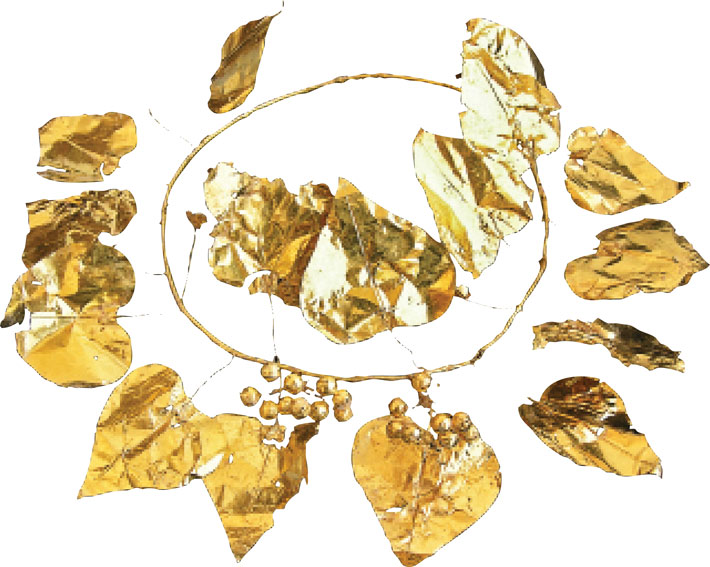 Archaeologists are getting a new look at how the other half lived in Classical-era Cyprus thanks to artifacts unearthed at a 2,400-year-old necropolis on the island’s northern coast. Discovered during construction of a pipeline, the tombs were near the ancient city of Soloi, a leading supplier of copper and timber for the Athenian navy. The remains of three adults and two young girls were found in two unlooted chambers. The grave goods that accompany them suggest that the Athenian trade was prosperous. “This was a rich aristocratic family,” says Ankara University archaeologist Hazar Kaba, who analyzed the artifacts. “Even the children were adorned with elaborate funerary jewelry.”
Archaeologists are getting a new look at how the other half lived in Classical-era Cyprus thanks to artifacts unearthed at a 2,400-year-old necropolis on the island’s northern coast. Discovered during construction of a pipeline, the tombs were near the ancient city of Soloi, a leading supplier of copper and timber for the Athenian navy. The remains of three adults and two young girls were found in two unlooted chambers. The grave goods that accompany them suggest that the Athenian trade was prosperous. “This was a rich aristocratic family,” says Ankara University archaeologist Hazar Kaba, who analyzed the artifacts. “Even the children were adorned with elaborate funerary jewelry.”
Many objects discovered in the tombs, including a delicate gold wreath shaped like an ivy plant, and 16 bronze and silver vessels, were from Greece. A figurine depicting Aphrodite and her son Eros was made locally but in the Athenian style, suggesting to Kaba that artisans from Athens may have been living in Soloi. Other artifacts came from Anatolia to the north and the Achaemenid Empire to the east. “While the majority of the goods used by these aristocrats were imported from Greece, it was exciting to see that a large amount of Cypriot and Eastern goods were also present,” says Kaba. “All this evidence points to a way of living that was combining Greek, Cypriot, and Eastern customs and culture together.”
Finding Parker’s Revenge
By JASON URBANUS
Monday, December 07, 2015
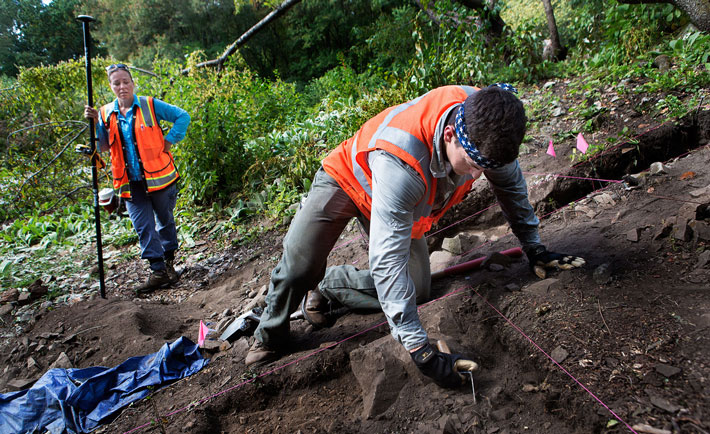 Archaeologists working in Lexington, Massachusetts, are investigating the little-known site of Parker’s Revenge, a small yet important skirmish that took place in the opening hours of the Revolutionary War. On April 19, 1775, tensions between Massachusetts colonists and the British army finally broke out in bloodshed at Lexington Green, as a battalion of 700 British regulars fired on as many as 77 local militiamen led by Captain John Parker. The redcoats, who had marched that morning from Boston, were headed to the neighboring village of Concord to destroy a cache of colonial military supplies. As they undertook their 17-mile journey back to Boston, matters quickly turned nightmarish as thousands of colonial militia from the surrounding countryside lined the road and began to attack the retreating column. The British faced particularly heavy fire from a rocky hillside overlooking the road. This engagement is now known as Parker’s Revenge, in which the Lexington captain rallied his troops after the morning’s defeat to ambush the unsuspecting British.
Archaeologists working in Lexington, Massachusetts, are investigating the little-known site of Parker’s Revenge, a small yet important skirmish that took place in the opening hours of the Revolutionary War. On April 19, 1775, tensions between Massachusetts colonists and the British army finally broke out in bloodshed at Lexington Green, as a battalion of 700 British regulars fired on as many as 77 local militiamen led by Captain John Parker. The redcoats, who had marched that morning from Boston, were headed to the neighboring village of Concord to destroy a cache of colonial military supplies. As they undertook their 17-mile journey back to Boston, matters quickly turned nightmarish as thousands of colonial militia from the surrounding countryside lined the road and began to attack the retreating column. The British faced particularly heavy fire from a rocky hillside overlooking the road. This engagement is now known as Parker’s Revenge, in which the Lexington captain rallied his troops after the morning’s defeat to ambush the unsuspecting British.
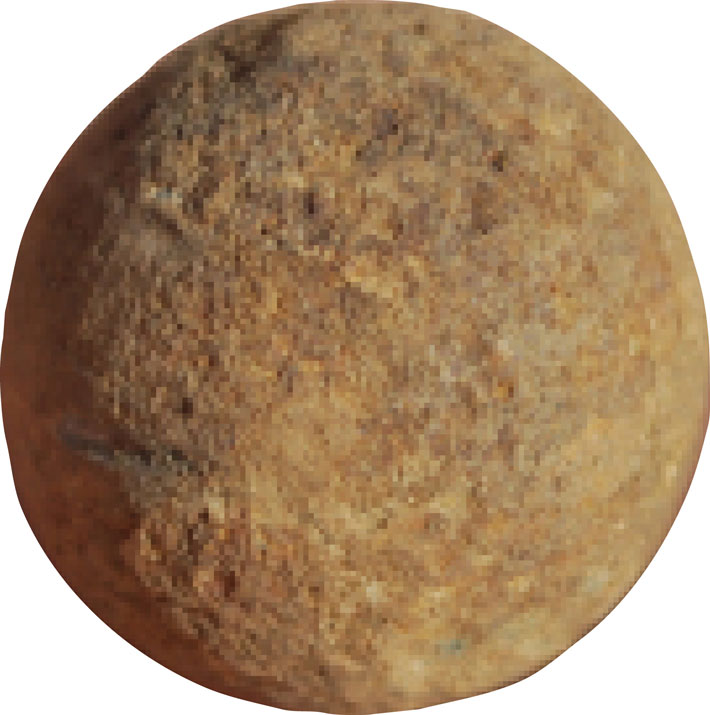 The Parker’s Revenge Archaeological Project has been working at the 44-acre site in Minute Man National Historical Park to reconstruct the events and landscape of the eighteenth-century encounter. They have employed a number of archaeological methods, including excavation, geophysical survey, 3-D laser scanning, and metal detection. Relying on the principles associated with battlefield archaeology, researchers are using retrieved musket balls, both dropped and fired, to determine the location of the combatants and the intensity of the fighting. “What we have found to date is very significant,” says project archaeologist Meg Watters. “Due to the location and spatial patterning of the musket balls recovered, we now know the exact place where individuals were standing during the battle.” This will allow archaeologists to begin to paint a much clearer picture of what happened that day.
The Parker’s Revenge Archaeological Project has been working at the 44-acre site in Minute Man National Historical Park to reconstruct the events and landscape of the eighteenth-century encounter. They have employed a number of archaeological methods, including excavation, geophysical survey, 3-D laser scanning, and metal detection. Relying on the principles associated with battlefield archaeology, researchers are using retrieved musket balls, both dropped and fired, to determine the location of the combatants and the intensity of the fighting. “What we have found to date is very significant,” says project archaeologist Meg Watters. “Due to the location and spatial patterning of the musket balls recovered, we now know the exact place where individuals were standing during the battle.” This will allow archaeologists to begin to paint a much clearer picture of what happened that day.
Denmark’s Bog Dogs
By ZACH ZORICH
Monday, December 07, 2015
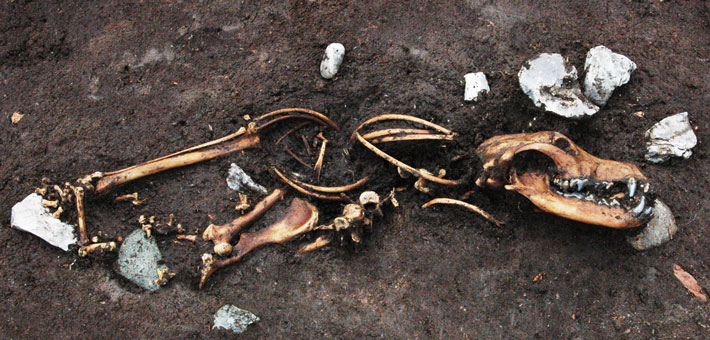
A salvage excavation at the site of a new housing development near Aarhus, Denmark, has revealed the remains of sacrificial victims, including a headless woman and eight dogs, who were dropped into a bog more than 2,000 years ago. Per Mandrup of Denmark’s Moesgaard Museum led the excavation. While the bodies of humans preserved in bogs have received a lot of scholarly attention, less is known about dogs. “It’s always surprising to find so many dogs and also find a human,” says Mandrup. “It was the jackpot.” The dogs appear to have been a breed similar to border collies that was probably used for sheep herding. Leashes were found with some of the dogs, but how they were killed is not known. Other sacrifices have been found in another nearby bog, including burned human bones, iron weapons, and 13 more dog skeletons. According to Mandrup, “We can see there was a lot of sacrifice in that area, which is not normal.”
Leftover Mammoth
By ERIC A. POWELL
Monday, December 07, 2015
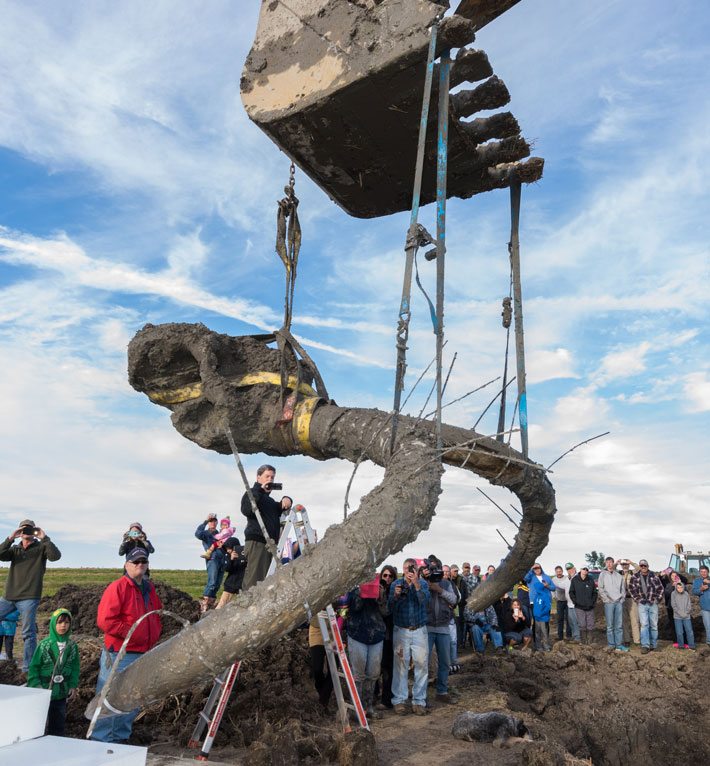 While installing a drainage pipe in his wheat field, a Michigan farmer was surprised to unearth a section of mammoth pelvis. A team led by University of Michigan paleontologist Daniel Fisher then excavated there and recovered 20 percent of the animal’s bones, including its skull and tusks. Fisher notes that the bones were arranged in the correct anatomical order, which means they likely never lay on the surface, exposed to the elements and scavengers. He thinks that’s because the mammoth was probably butchered by humans, who then stored some of the meat in a pond for future use. Boulders found near the skull might have been used to help weigh down the carcass. “Maybe something happened to the people, or maybe they didn’t need the meat,” says Fisher. “But for whatever reason, they never came back.”
While installing a drainage pipe in his wheat field, a Michigan farmer was surprised to unearth a section of mammoth pelvis. A team led by University of Michigan paleontologist Daniel Fisher then excavated there and recovered 20 percent of the animal’s bones, including its skull and tusks. Fisher notes that the bones were arranged in the correct anatomical order, which means they likely never lay on the surface, exposed to the elements and scavengers. He thinks that’s because the mammoth was probably butchered by humans, who then stored some of the meat in a pond for future use. Boulders found near the skull might have been used to help weigh down the carcass. “Maybe something happened to the people, or maybe they didn’t need the meat,” says Fisher. “But for whatever reason, they never came back.”
Buddha Stands Tall
By HYUNG-EUN KIM
Monday, December 07, 2015
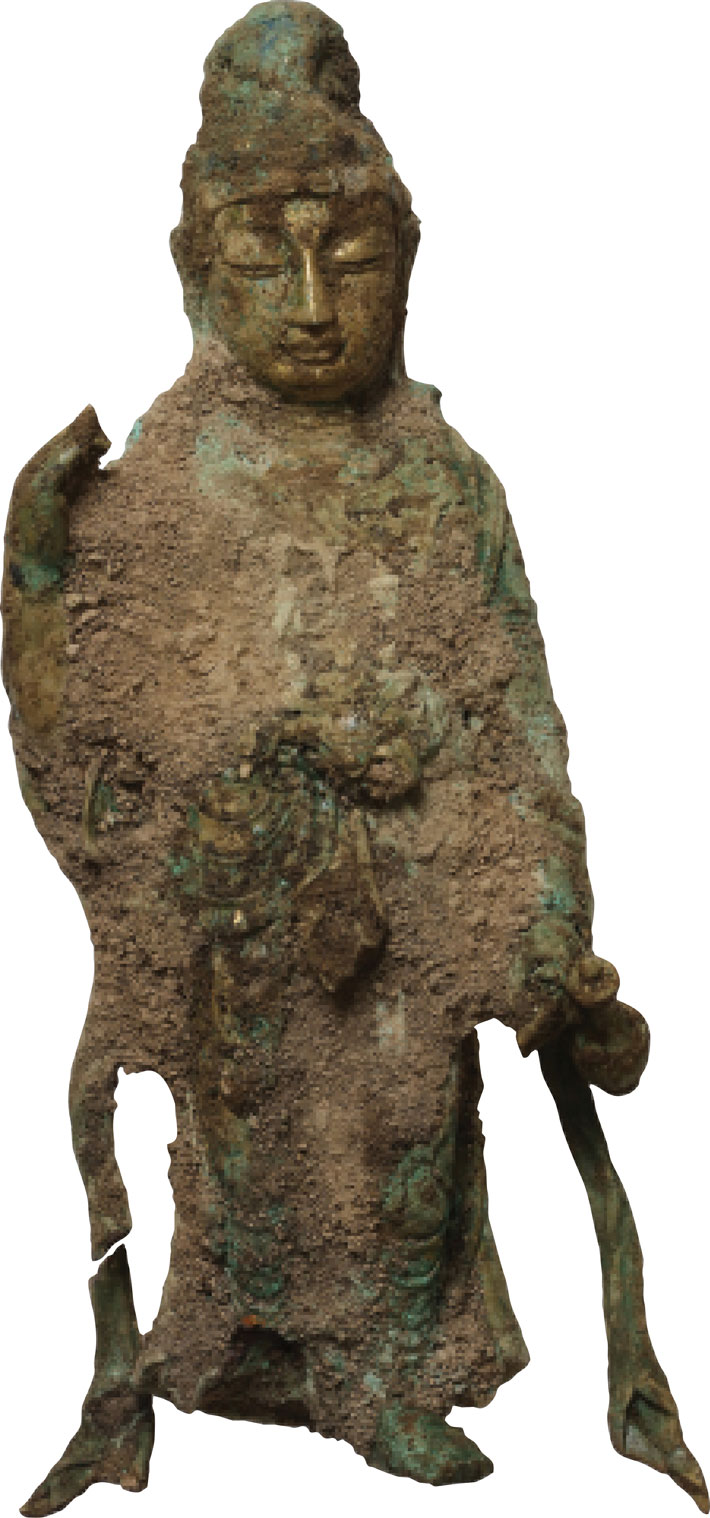 Korean archaeologists have uncovered a ninth-century Buddhist statue from the Unified Silla period (A.D. 676–935) at a temple site in Yangyang County, Gangwon Province. The statue is the largest known Buddha from the era, and also one of the most intricately decorated from the entire Silla Dynasty (57 B.C.–A.D. 935). The gilt-bronze Buddha measures about 16 inches in height, but when the statue is assembled as a complete set, with the mandorla (halo) on top and pedestal on the bottom, it is taller than 20 inches, say researchers at the Hanbit Institute of Cultural Properties. Buddhist statues from this era are usually about half that size. It is also very rare to find gilt-bronze Buddhist statues in Korea that include the mandorla and pedestal.
Korean archaeologists have uncovered a ninth-century Buddhist statue from the Unified Silla period (A.D. 676–935) at a temple site in Yangyang County, Gangwon Province. The statue is the largest known Buddha from the era, and also one of the most intricately decorated from the entire Silla Dynasty (57 B.C.–A.D. 935). The gilt-bronze Buddha measures about 16 inches in height, but when the statue is assembled as a complete set, with the mandorla (halo) on top and pedestal on the bottom, it is taller than 20 inches, say researchers at the Hanbit Institute of Cultural Properties. Buddhist statues from this era are usually about half that size. It is also very rare to find gilt-bronze Buddhist statues in Korea that include the mandorla and pedestal.
Researchers say the way the figure is holding the kundika (the water vessel used in Buddhist ceremonies) is also unusual. The vessel is held by its handle, whereas in most images of Buddha, the figures are holding the vessel by its long neck or mouth. Scholars are currently studying the statue further, and given its artistic and academic value, they expect it to be designated a state treasure.
Advertisement
Advertisement
IN THIS ISSUE
Features
Top 10 Discoveries of 2015
The Many Lives of an English Manor House
Family History
Letter from Hawaii
From the Trenches
Reading the Invisible Ink
Off the Grid
Irish Roots
A Kestrel’s Last Meal
Pompeii Before the Romans
A Baltic Sea Monster Surfaces
Built upon Bones
An Opportunity for Early Humans in China
Hidden Blues
Mr. Jefferson’s Laboratory
Under a Haitian Palace
From Yacht to Trawler to Wreck
Buddha Stands Tall
Denmark’s Bog Dogs
Leftover Mammoth
Finding Parker’s Revenge
Living the Good Afterlife
Artifact
How a Medusa survived Christianity
Advertisement

Recent Issues
-
 May/June 2024
May/June 2024
-
 March/April 2024
March/April 2024
-
 January/February 2024
January/February 2024
-
 November/December 2023
November/December 2023
-
 September/October 2023
September/October 2023
-
 July/August 2023
July/August 2023
-
 May/June 2023
May/June 2023
-
 March/April 2023
March/April 2023
-
 January/February 2023
January/February 2023
-
 November/December 2022
November/December 2022
-
 September/October 2022
September/October 2022
-
 July/August 2022
July/August 2022
-
 May/June 2022
May/June 2022
-
 March/April 2022
March/April 2022
-
 January/February 2022
January/February 2022
-
 November/December 2021
November/December 2021
-
 September/October 2021
September/October 2021
-
 July/August 2021
July/August 2021
-
 May/June 2021
May/June 2021
-
 March/April 2021
March/April 2021
-
 January/February 2021
January/February 2021
-
 November/December 2020
November/December 2020
-
 September/October 2020
September/October 2020
-
 July/August 2020
July/August 2020
-
 May/June 2020
May/June 2020
-
 March/April 2020
March/April 2020
-
 January/February 2020
January/February 2020
-
 November/December 2019
November/December 2019
-
 September/October 2019
September/October 2019
-
 July/August 2019
July/August 2019
-
 May/June 2019
May/June 2019
-
 March/April 2019
March/April 2019
-
 January/February 2019
January/February 2019
-
 November/December 2018
November/December 2018
-
 September/October 2018
September/October 2018
-
 July/August 2018
July/August 2018
-
 May/June 2018
May/June 2018
-
 March/April 2018
March/April 2018
-
 January/February 2018
January/February 2018
-
 November/December 2017
November/December 2017
-
 September/October 2017
September/October 2017
-
 July/August 2017
July/August 2017
-
 May/June 2017
May/June 2017
-
 March/April 2017
March/April 2017
-
 January/February 2017
January/February 2017
-
 November/December 2016
November/December 2016
-
 September/October 2016
September/October 2016
-
 July/August 2016
July/August 2016
-
 May/June 2016
May/June 2016
-
 March/April 2016
March/April 2016
-
 January/February 2016
January/February 2016
-
 November/December 2015
November/December 2015
-
 September/October 2015
September/October 2015
-
 July/August 2015
July/August 2015
-
 May/June 2015
May/June 2015
-
 March/April 2015
March/April 2015
-
 January/February 2015
January/February 2015
-
 November/December 2014
November/December 2014
-
 September/October 2014
September/October 2014
-
 July/August 2014
July/August 2014
-
 May/June 2014
May/June 2014
-
 March/April 2014
March/April 2014
-
 January/February 2014
January/February 2014
-
 November/December 2013
November/December 2013
-
 September/October 2013
September/October 2013
-
 July/August 2013
July/August 2013
-
 May/June 2013
May/June 2013
-
 March/April 2013
March/April 2013
-
 January/February 2013
January/February 2013
-
 November/December 2012
November/December 2012
-
 September/October 2012
September/October 2012
-
 July/August 2012
July/August 2012
-
 May/June 2012
May/June 2012
-
 March/April 2012
March/April 2012
-
 January/February 2012
January/February 2012
-
 November/December 2011
November/December 2011
-
 September/October 2011
September/October 2011
-
 July/August 2011
July/August 2011
-
 May/June 2011
May/June 2011
-
 March/April 2011
March/April 2011
-
 January/February 2011
January/February 2011
Advertisement






